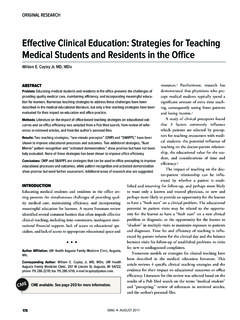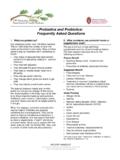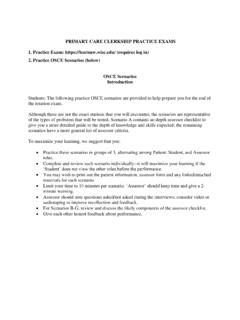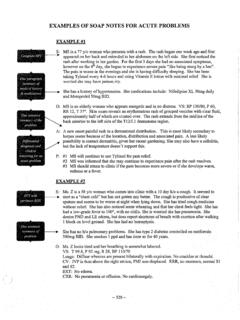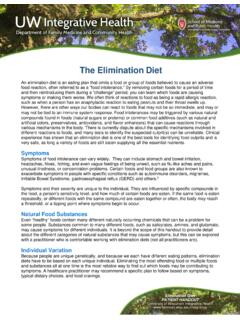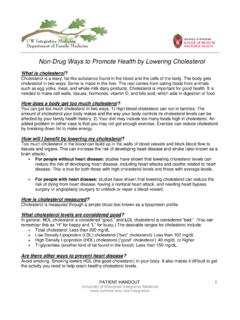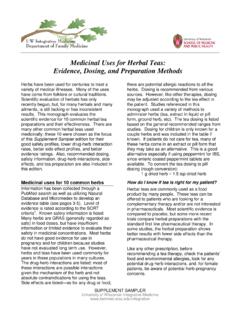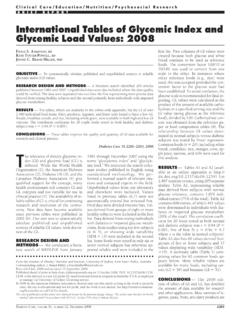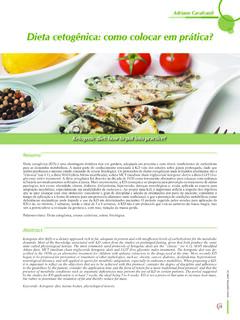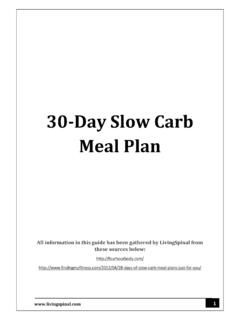Transcription of Managing Carbohydrates for Better Health
1 Managing Carbohydrates PATIENT HANDOUT University of Wisconsin Integrative Health 1 Managing Dietary Carbohydrates for Better Health Increasingly, scientific evidence is confirming that both the quantity and the quality of dietary Carbohydrates , proteins, and fats in the diet contribute to how much and how fast blood glucose (sugar) ris es after foods are consumed. glycemic index (GI) and glycemic load (GL) are two objective ways of measuring blood sugar response to foods. Insulin is an important hormone that helps the body to use and manage blood sugar. The food insulin index (FII) is a measure of how much insulin the body normally releases in response to a whole food or meal.
2 All of these factors contribute to how the body manages blood sugar and energy. This handout explains these concepts and how they can be used to manage the effects of Carbohydrates for Better Health . What is the glycemic index ? When we eat carbohydrate -containing foods (sugars and starches), our bodies convert the sugars and starches to glucose, which then enters the bloodstream and makes our blood glucose (sugar) levels rise. Various carbohydrate -containing foods affect blood sugar levels differently. This is because the quality of carbohydrate , the matrix or structure of the food, how the food is prepared, and the presence of other substances in the food such as fat, protein, and fiber can affect the extent that the glucose is released and absorbed into the blood stream.
3 The glycemic index (GI) of a food is a numerical ranking, on a scale of 0 to 100 of the extent to which a food will raise blood sugar after eating it. The glycemic index compares the rise in blood sugar level after eating a particular food to a reference food, often the sugar glucose (glucose is a very basic sugar and not the same as table sugar). One of the foods that is often used as a reference food is white bread. It has a relatively high glycemic index of 70 when compared to glucose, which has an index of 100. A high glycemic index may be considered to be a number between 70 and 100; medium, between 50 and 70; and low, under 50 (See Table 1).
4 The GI of a food is measured by feeding 10 healthy people a portion of the food containing 50 grams of digestible (available) carbohydrate and then measuring the effect on their blood sugar for the next 2 hours. High GI Low GI Managing Carbohydrates PATIENT HANDOUT University of Wisconsin Integrative Health 2 What is the glycemic load (GL)? The glycemic index of a particular food can be a useful value to understand the relative ranking of different foods, but does not accurately reflect the effect on blood sugar of an actual serving of food. This is where the glycemic load (GL) comes in. The GL combines both the quality and the quantity of carbohydrate into one value.
5 You can think about GL as the amount of carbohydrate in a food adjusted for its glycemic potency. GL is a more accurate way to predict the impact on blood glucose of different types and amounts of food. For example, watermelon has a high GI (72-80), but a low GL (4-5) because there isn t a lot of sugar in a serving of watermelon, since it is mostly water and fiber. One serving of watermelon (120 grams) only contains 6 grams of carbs. A GL below 10 is considered low , from 11 to 19 moderate , and above 20 is high (See Table 1). Table 1 Reference Ranges Relative Level glycemic index glycemic Load High 70-100 >20 Moderate 55-69 11-19 Low <55 <10 The Food Insulin index (FII) The GI and GL are useful indicators of how blood sugar is affected by a food, but they are still only part of the story.
6 When we eat carb-containing foods, blood sugar rises and the body (specifically, the pancreas) produces the hormone insulin that acts like a key to open the door to the cells and shuttle the sugar out of the bloodstream and into the cells. It can be used for immediate energy or stored as glycogen or fat. Insulin acts like a hormonal switch that helps the body to store energy in times of plenty. During times of food scarcity, lower levels of insulin help the body to access stored energy for fuel. The amount of insulin produced as a result of food intake is a complex process and is affected not only by carb-containing foods, but also by the amount and type of protein and fat, the food matrix, and other factors.
7 The insulin response to foods is not always proportional to the GI or GL because these values only account for carb-containing Enter the food insulin index (FII). The FII is a ranking of foods based on the insulin response to equal caloric portions of various whole foods and mixed meals. The FII measures the increase in insulin as opposed to the GI or GL which measure the increase in blood-sugar. The FII is dependent on the quantity and quality of carbohydrate , protein and fat and how they interact. However, because insulin secretion is complex, the FII cannot necessarily be predicted from the amounts of carbohydrate , protein, and fat in a food or mixed meal and must be tested and measured in Choosing foods to lower your insulin demand , or how much insulin your body needs to make to metabolize your food, may be an additional tool to help you lower the stress on your pancreas.
8 This may reduce the risk for weight gain, development of diabetes, and other Health problems 3. The GL of a food is calculated by multiplying the GI of that food by the amount of carbohydrate in an actual serving of the food. Low GL meals are recommended for weight loss and Better blood sugar control. Managing Carbohydrates PATIENT HANDOUT University of Wisconsin Integrative Health 3 Tips for Using the Food Insulin index Table 2 below contains the FII for a selection of foods. More research is needed to catalog larger numbers and varieties of foods. However, recent research on the FII allows for the following generalizations and helpful suggestions: Generally speaking, the higher the GL, the higher the FII, but not always.
9 Notable examples include regular and sweet potatoes that both have higher FII than their GL would suggest. Of the grain-based carbohydrate -rich foods, lower FII choices include pasta and noodles. These are best cooked al dente to keep the insulin response low. Rice, bread, and couscous tend to be high FII foods, even their whole-grain versions. So choose whole, unprocessed grains whenever possible. Choose higher fiber bread and cereal options that have a lower FII, like grainy bread made with whole grains and seeds, and traditional whole grain breakfast cereals like rolled oats. Make sure to balance meals with some carbs, lean protein, healthy fats, and lots of salad or non-starchy vegetables.
10 Since most all foods stimulate insulin, you cannot entirely eliminate an insulin response. Dietary fat by itself does not stimulate insulin secretion, but when added to Carbohydrates , it amplifies the insulin response over the carbohydrate alone. This means two things: 1) be careful with added fat, some is OK, but more not only increases calories, it may also increase your insulin demand; and 2) Keep your carb amounts under control and choose low GL and FII options. Good snack choices include fruit and non-starchy vegetables with bean dips, as these are low FII foods and also full of vitamins, minerals and fiber.
